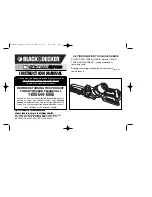
Page 5
Item 97360
For technical questions, please call 1-888-866-5797.
be aligned to the blade after blade
adjustment to prevent binding.
9.
As noted previously,
Kickback
is a sudden
reaction to a pinched, bound, or misaligned
blade, causing an uncontrolled workpiece to
lift up and out of the saw toward the operator.
Kickback is usually a result of tool
misuse and can be limited or avoided
by following the precautions below:
• Fence must be completely
parallel to the saw blade.
• Workpiece must be free from flaws
and from foreign objects.
• Do not use a dull or damaged blade.
• Maintain control of the workpiece. Do not
allow the workpiece to rest against the
moving blade without holding onto it.
• If the blade binds or a cut is interrupted,
turn off the power switch and hold
the workpiece still until the blade
stops. Correct the cause of blade
binding before proceeding.
• Before continuing an unfinished cut,
center the blade in the pre-cut kerf and
check that the saw is not engaged into
the workpiece before turning on the saw.
• Push the tile past the blade prior to release.
10. Check guards for proper operation with saw
disconnected from power before each use.
Do not disable any guard. Do not operate
saw if any movable guard does not move
freely and close instantly. Make sure any
movable guard does not touch the blade in
all angles, depths of cut, and positions.
11. Keep the guard in place while through-
sawing. Verify that the spreader lines
up with the blade to prevent binding.
POSITION OF TILE SAW
1.
To avoid the possibility of the tool plug or
receptacle getting wet, position tile saw
to one side of a wall mounted receptacle
to prevent water from dripping onto the
receptacle or plug. The user should arrange
a “drip loop” in the cord connecting the saw
to a receptacle. The “drip loop” is that part of
the cord below the level of the receptacle, or
the connector if an extension cord is used,
to prevent water traveling along the cord
and coming in contact with the receptacle.
2.
If the plug or receptacle does get wet,
DON’T unplug the cord. Disconnect the
fuse or circuit breaker that supplies power
to the tool. Then unplug and examine for
presence of water in the receptacle.
EXTENSION CORDS
3.
Use only extension cords that are intended
for outdoor use. These extension cords
are identified by a marking “Acceptable
for use with outdoor tools; store indoors
while not in use.” Use only extension cords
having an electrical rating not less than the
rating of the product. Do not use damaged
extension cords. Examine extension cord
before using and replace if damaged. Do
not abuse extension cords and do not
yank on any cord to disconnect. Keep
cord away from heat and sharp edges.
Always disconnect the extension cord
from the receptacle before disconnecting
the product from the extension cord.
4.
WARNING
– To reduce the risk of
electrocution, keep all connections






































